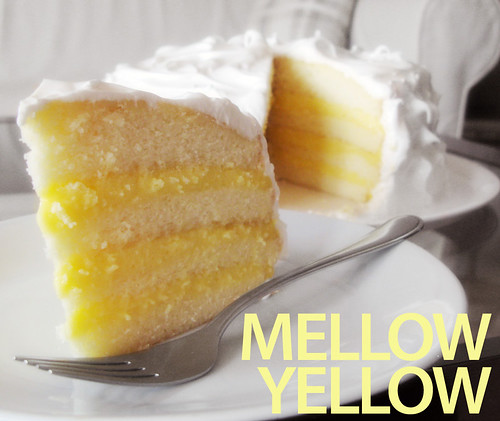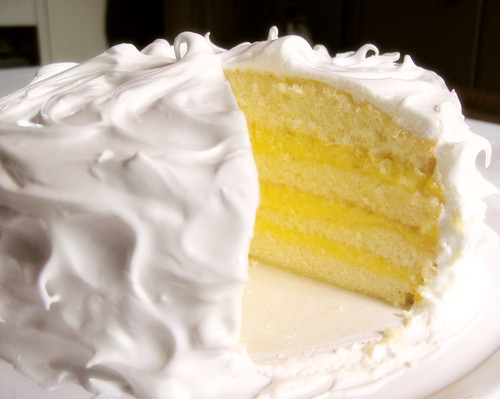Luscious Lemon Layer Cake

It's rare that you hear someone making a whole cake to use up leftover lemons, but if you bake as often as I do, you will have pounds of butter, dozens of eggs, jars of flour, and mountains of sugar just waiting to be used at the moment's notice. It's often much easier than having to go to the "farmer's market" specifically for fresh seafood to be cooked with the lemon, not to say that I didn't wish the fishmonger was just next door (at least I'd gain less pounds that way).
Because I didn't have enough lemon juice, I filled in the requirement with Philippine Lemon (Calamansi) juice-- very similar but slightly sourer. The resulting lemon curd was as perfect as could be. I love that this cake is so complex and requires care to make, but it still has "home baking" written all over it. Nothing convoluted about it. (Recipe follows)
The procedure for making white cake here is the most unique one I've ever seen, but I barely deviated from the procedure because I wanted to try it out. The crumb is perfect, but barely different from the usual method for making butter cakes. I changed the procedure for making lemon curd to resemble Pierre Hermé's method more, because it's easier, and I deviated slightly in making the icing as I wasn't really bothered making it entirely over the stove (my arms can take a lot of punishment, I guess).
Lemon Layer Cake
Take 1 tablespoon of the citrus juice and place into a bowl. Sprinkle the gelatin on top and set aside. In a heavy-bottomed saucepan, combine the remaining citrus juice, sugar, and salt and set over medium-high heat until the sugar just dissolves (you can see all of the bottom of the pan at this point; avoid letting it boil). Place the eggs and yolks in a large bowl and whisk together. Still whisking vigorously, add half the hot juice in a thin stream, then you can liberally add the rest while whisking. Return to the stove over low-medium heat, stirring constantly until a thermometer registers 170°F (77°C) or the curd coats the back of the spoon and a track drawn through it doesn't fill with the curd (the mixture will have been boiling for about 1-2 minutes). Take off the heat and stir in the juice-gelatin mixture. Strain using a fine-meshed sieve into a blender. By this time it will have cooled to 140°F (60°C). Start the blender and drop the cubes of butter in one by one. When the butter is halfway in, stop the blender and scrape down the sides, then continue until all the butter is incorporated (the blender will not choke when the curd is smooth). If you don't have a blender, you can whisk the cubes of butter in but it will take longer to incorporate. Return to a bowl and let cool to room temperature, then place cling film flush against the surface, poke a few holes in the top and place in the fridge for at least 4 hours to firm up.
Set a rack in the middle of the oven and preheat at 350°F (177°C). Grease and line 2 9-inch cake pans (at least 2 inches high). In a bowl, whisk together the milk, egg whites, and vanilla. In the bowl of a standing mixer with the paddle attachment (I used a hand mixer with the usual beaters; you could also probably use a pastry blender and a whisk if you have neither), mix together the flour, sugar, baking powder, and salt at low speed to combine. Add the butter one piece at a time until the mixture resembles moist crumbs without visible butter chunks. Add all but 1/2 cup of the liquid mixture and beat at medium speed until pale and fluffy (90 seconds). Switch to low speed and add the rest of the liquid, then beat at medium speed for 30 more seconds. Scrape the sides of the bowl and beat on medium speed for 20 more seconds. Divide the batter evenly between the 2 pans (use you scale if you have one), then spin the pans on the counter to spread the batter. Bake for 23-25 minutes or until a toothpick in the center comes out with very few tiny moist crumbs. Run a thin knife around the edges and cool in the pans for 10 minutes, then unmold and cool on a rack for at least 2 hours.
If the cakes have domed while baking, flatten the top of one with a long, sharp serrated knife. Divide the 2 layers horizontally into 2 layers each. Set one of the layers on a cake round or serving plate and spoon a third of the curd, evening out with a spatula. Set the second layer on top and repeat with the rest of the curd and the cake, finishing off with a domed cake layer if you have one. Smooth out the run-off on the sides and refrigerate.
Combine all the ingredients in a heatproof bowl set over a pan of simmering water. Using a hand mixer on high speed, beat until the mixture holds stiff peaks (when you lift the beaters, the tips of the peaks on the surface will not droop), about 7-10 minutes. Take off the heat and cool to room temperature. Spread the frosting on the cake.















































